Cell Exam 3 Complete cardset
1/134
There's no tags or description
Looks like no tags are added yet.
Name | Mastery | Learn | Test | Matching | Spaced |
|---|
No study sessions yet.
135 Terms

Above is a dissociation graph of hemoglobin and myoglobin, two proteins capable of binding oxygen. Hemoglobin (show as the red curve) dissociates carbon monoxide (CO), a toxic gas, about 200 times less than it does oxygen. What would the curve for carbon monoxide-bound hemoglobin look like?
A. The curve would shift downward, even further away from the myoglobin curve than the hemoglobin-oxygen curve.
B. The curve would not change, and the carbon-monoxide curve would resemble the current hemoglobin-oxygen curve.
C. The curve would shift upward, more closely resembling the myoglobin curve.
C. The curve would shift upward, more closely resembling the myoglobin curve.
Which of the following polypeptides is most likely to bind to a receptor in the nucleus?
A. a nonpolar polypeptide
B. a polar polypeptide
C. an acidic polypeptide
D. a basic polypeptide
A. a nonpolar polypeptide
Which of the following are likely to increase the strength and length of a signal?
A. Decreasing the dissociation constant of the receptor molecule
B. Increasing the concentration of the signaling molecule
C. All of these are likely to increase the strength and length of a signal.
D. Increasing the number of receptor molecules
C. All of these are likely to increase the strength and length of a signal.
Which of the following is NOT a form of cell-to-cell signaling?
A. Simulacrine signaling
B. Endocrine signaling
C. Paracrine signaling
D. All of these are forms of cell-to-cell signaling
A. Simulacrine signaling
Which of the following is NOT a feature of G-Protein coupled receptors (GPCRs)?
A. GPCRs mostly consist of three subunits: a transmembrane subunit and two cytosolic subunits.
B. All of these are features of GPCRs.
C. Ligand binding causes a conformational change in the subunits of a GPCR to enable it to activate the G-protein effector.
D. GPCRs are active when they are bound by GDP and inactive when they are bound by GTP.
D. GPCRs are active when they are bound by GDP and inactive when they are bound by GTP.
Which of the following pathways is most likely going to result in a short-term, rapid response by a receiving cell?
A. Growth hormone (stimulates growth, tissue development and repair)
B. Artemin (produced by zygote to suppress apoptosis and promote cell differentiation)
C. Norepinepherine (triggers fight-flight-freeze response)
D. Androgens (stimulate development of sex characteristics)
C. Norepinepherine (triggers fight-flight-freeze response)
Selective serotonin reuptake inhibitors (SSRIs) can increase the time serotonin, a signaling molecule, spends outside of cells. What effect do SSRIs likely have on the serotonin-receptor equilibrium?
A. There will be no change in the number of serotonin receptors since SSRIs do not alter the dissociation constant of the serotonin receptors.
B. Fewer serotonin receptors will be bound.
C. More serotonin receptors will be bound.
C. More serotonin receptors will be bound.
T/F Some G-Protein coupled receptors cause ion channels to open.
True
T/F Cellular responses depend on the type of receptor present; the same signaling molecule can elicit different responses depending on the receptors present.
True
Which of the following best explains the benefit of signal amplification?
A. It decreases the sensitivity of the cell to the same stimulus.
B. It enables the cell to rapidly stop a cell signaling cascade.
C. It allows for a small amount of signaling molecule to generate a large and/or prolonged cellular response.
D. It enables different cells to respond to the same signaling molecule in different ways.
C. It allows for a small amount of signaling molecule to generate a large and/or prolonged cellular response.
Which of the following is the most common cellular response from RTKs?
A. Ubiquitination
B. Cellular restructuring
C. Changes in enzyme activity
D. Changes in transcription rates
D. Changes in transcription rates
T/F PI3 kinases are activated by the same receptors as many tyrosine kinase pathways.
True
Arrange the following events in the Ras/MAP Pathway.
Signaling molecule binds to the receptor
Signaling molecule binds to the receptor
GDP is swapped for GTP in Ras, activating it.
Raf is phosphorylated and activated.
MEK is phosphorylated and activated.
MAP is phosphorylated and activated.
Transcription factors in the nucleus are activated.
Which of the following best explains why the Wnt pathway is not used by unicellular eukaryotes?
A. Only humans produce Wnt.
B. It is slower than traditional signal transduction pathways.
C. It does not result in amplification of the signal, as seen in other signal transduction pathways.
D. It wastes molecular resources by constantly being "on."
D. It wastes molecular resources by constantly being "on."
Which of the following best describes what kinases do?
A. Act as transcription factors, up-regulating or down-regulating transcription in the nucleus
B. Act as signaling molecules, binding to receptors to activate a signaling pathway
C. Act as enzymes, transferring a phosphate from ATP to a substrate
D. Act as receptors, binding to signaling molecules to activate a signaling pathway
C. Act as enzymes, transferring a phosphate from ATP to a substrate
T/F Cytokine receptors can activate many of the same kinase pathways as RTKs.
True
Which of the following environments would signal the pancreas to STOP releasing insulin?
A. Low calcium levels in the blood
B. High glucagon levels in the blood
C. Low oxygen levels in the blood
D. Low glucose levels in the blood
D. Low glucose levels in the blood
Which of the following best describes the relationship between insulin and glucagon?
A. Tangential: The signals don't interact strongly and neither interfere nor promote the response of the other
B. Inhibitory: The signals initiate opposite responses in the cell
C. Synergistic: The signals reinforce and amplify the cellular response
B. Inhibitory: The signals initiate opposite responses in the cell
What is the cellular response of the insulin pathway in fat cells?
A. Degrade glucagon in cytoplasm
B. Transcribe glucagon in nucleus
C. Increase GLUT4 transporter in membrane
D. Decrease Na-K pump in membrane
C. Increase GLUT4 transporter in membrane
What type of signal transduction pathway best describes the insulin receptor pathway in fat and muscle cells?
A. Protein regulation pathway
B. G-Protein coupled receptor
C. Enzyme receptor
D. none of these describe the insulin pathway
C. Enzyme receptor
What is the cellular response of the insulin pathway in liver cells? Select ALL that apply.
Phosphorylation of GSK3 for glycogen synthesis
Decrease Na-K pump in membrane
Increase transcription of glucagon
Increase GLUT4 transporter in membrane
Phosphorylation of GSK3 for glycogen synthesis
Increase GLUT4 transporter in membrane
Which of the following is NOT a requirement for a cellular response pathway (such as responding to blood sugar or low oxygen) for a cell to maintain homeostasis?
A. stimulus/signal
B. All of these are required
C. effector
D. sensor
B. All of these are required
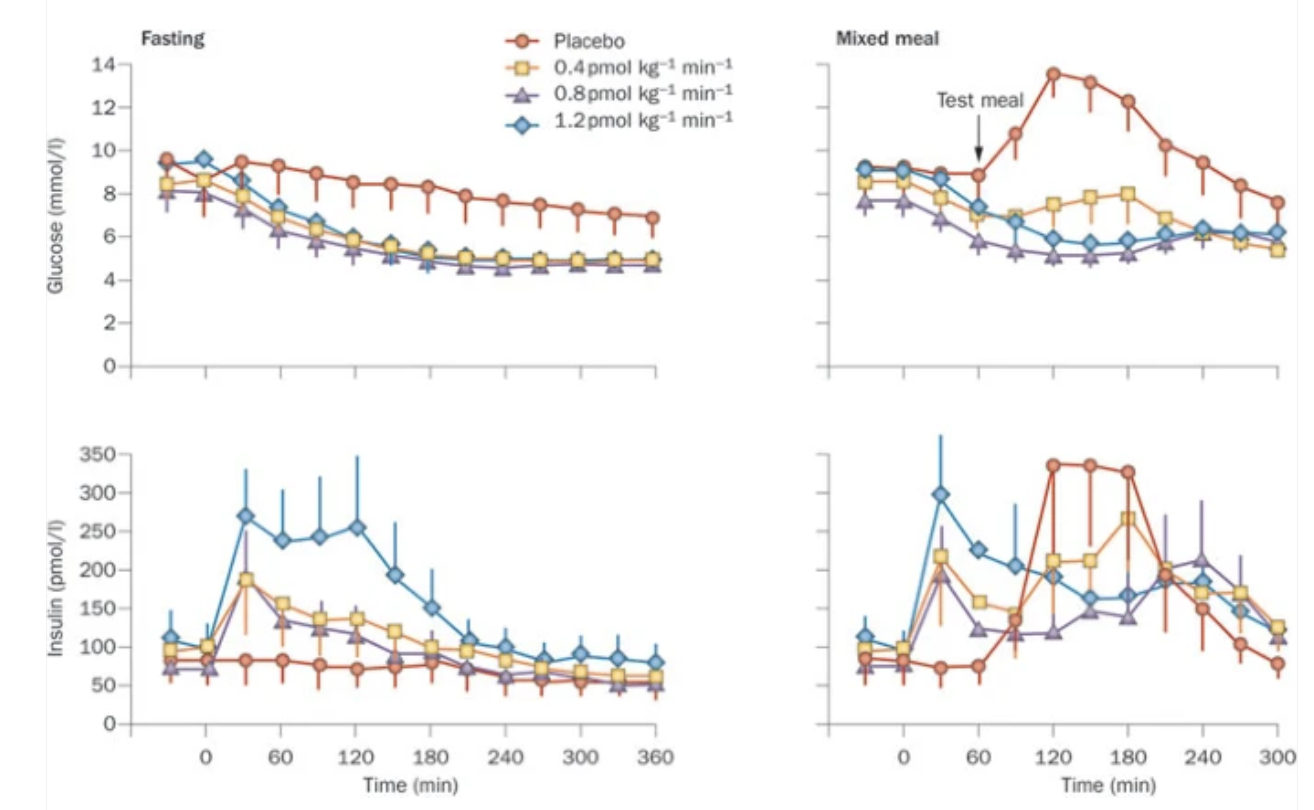
The figures above are from Meier (2012) of glucose or insulin over time under fasting or fed conditions. Patients in the trial were given 0.4 pmol, 0.8 pmol, or 1.2 pmol of GLP-1 or a placebo (0 pmol of GLP-1). Which of the following best explains why administration of GLP-1 in these patients resulted in lower blood glucose levels while fasting?
A. GLP-1 inhibited insulin production.
B. GLP-1 inhibited insulin production.
C. GLP-1 activated glucose transporters in the liver.
D. GLP-1 stimulated insulin production.
D. GLP-1 stimulated insulin production.
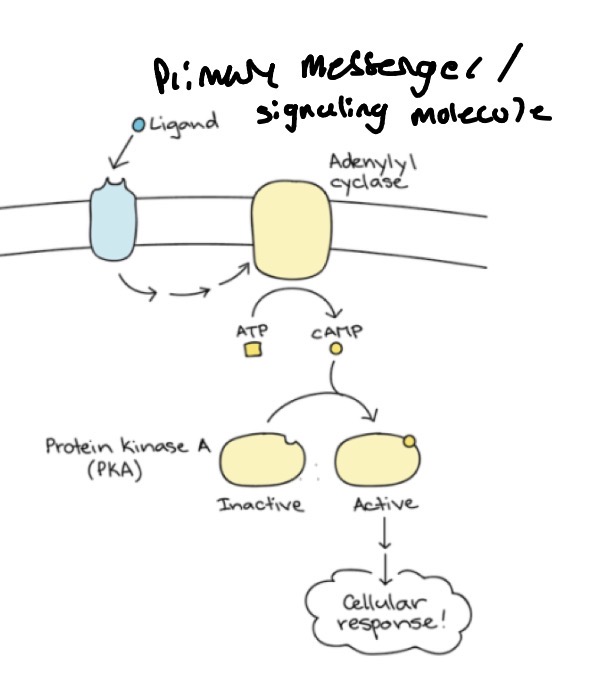
According to the diagram on the right, which molecule is the
secondary messenger?
1. Ligand
2. Adenylyl cyclase
3. cAMP
4. Protein Kinase A (PKA)
3. cAMP
Core concepts of cell-to-cell communication
Response to signal depends on receptors
The use of signal transduction allows communication to be amplified
Cell signaling is tightly regulated
Dissociation constant (Kd)
Kd = (# of Receptor x # of Ligand) / (# of receptor bound to ligand)
Small Kd = receptors have higher binding affinity for signals
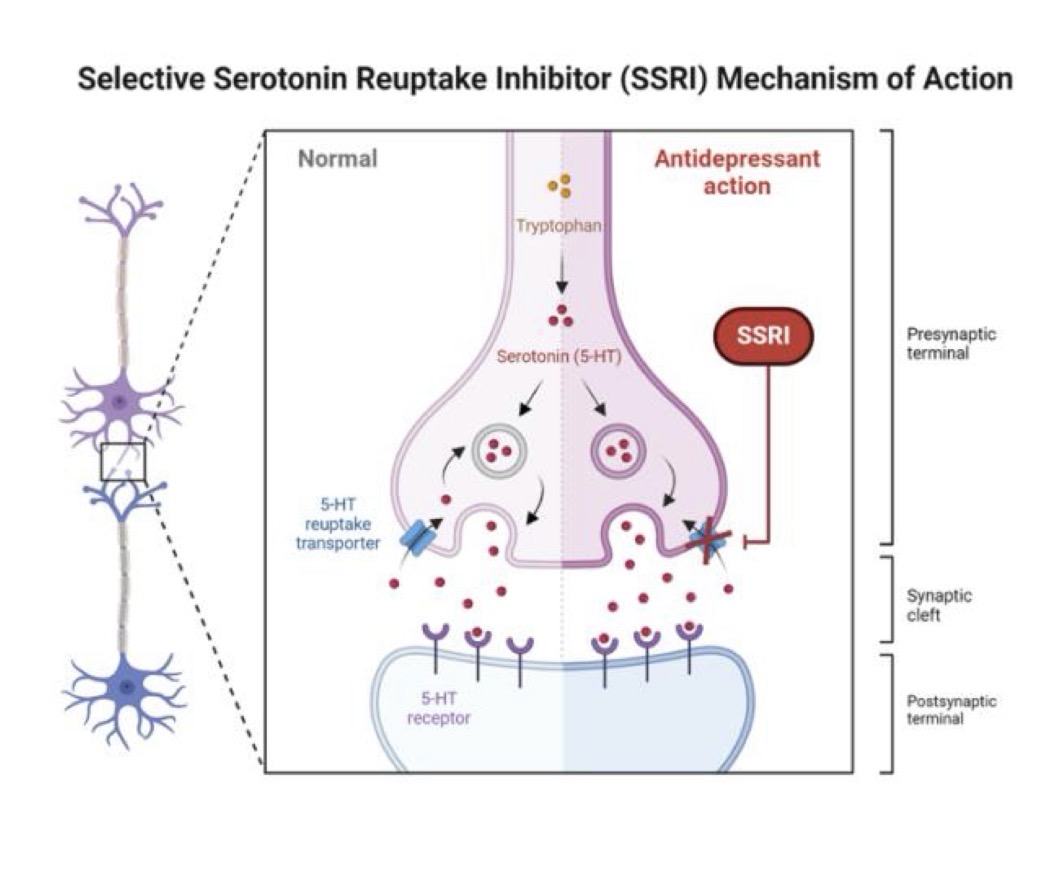
Serotonin is a neurotransmitter that is frequently associated with feelings of well-being, contentment and joy. Selective-serotonin reuptake inhibitors (SSRIs) are a common class of antidepressants and antianxiety medications. Their mechanism of action is shown to the right. How do SSRIs reduce anxiety/depression?
a. SSRIs increase the production of serotonin by
the signaling cell.
b. SSRIs increase the number of serotonin
receptors produced by the target cell.
c. SSRIs decrease the dissociation constant of
serotonin and the serotonin receptor.
d. None of the above
d. None of the above
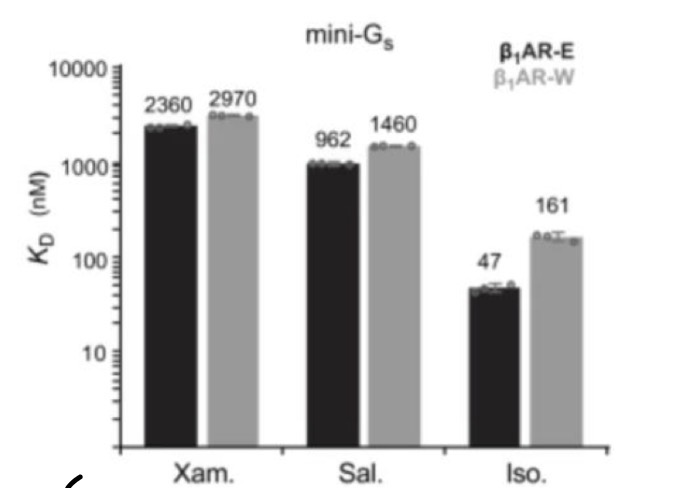
Jones et al (2024) compared the dissociation constant of three ligands (Xam, Sal, and Iso) for two alleles of the b1-A Receptor (E or W).
Which receptor (E or W) would produce a stronger signal? Explain.
E would produce stronger signal
Lower Kd (dissociating less) = higher binding affinity (stronger signal)
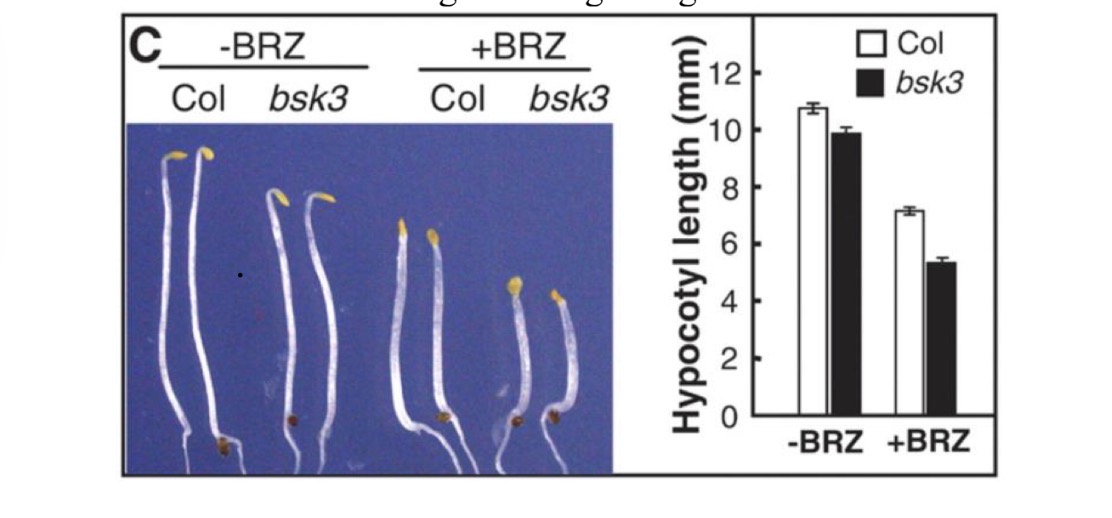
Tang et al (2008) wanted to understand the signaling pathway of BRI1, an enzyme receptor in Arabidopsis. After identifying BRZ as a product of the pathway, the researchers next treated seedlings with BRZ and observed their growth. Based on the graph below, which of the following statements are TRUE? Select ALL that apply.
“Col” = WT; bsk3 = mutant with poor binding to signaling molecule
1. BRZ enhances growth of Arabidopsis seedlings.
2. BRZ participates in a negative feedback loop.
3. Bsk3 mutants may interact with BRZ.
4. BRZ is binding to the signaling molecule.
2. BRZ participates in a negative feedback loop.
3. Bsk3 mutants may interact with BRZ.
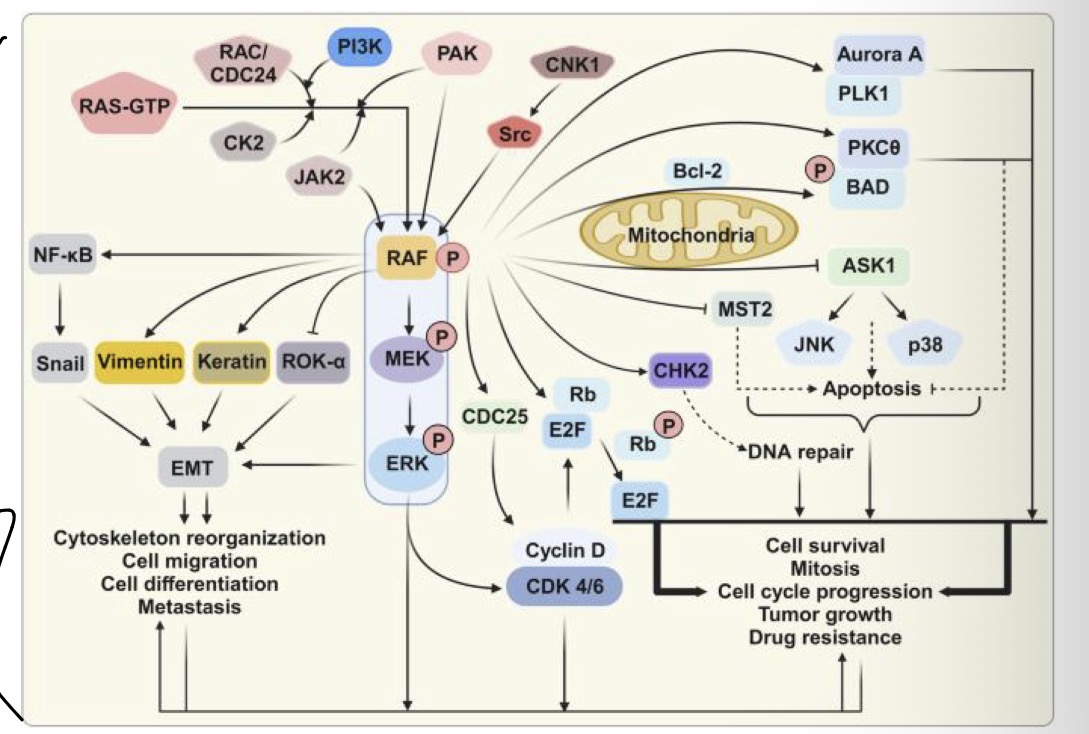
Which of the proteins on this map would be ideal targets for cancer treatment? Why?
Any that are more central on the map would better target cancer
Which of the following is the most likely outcome for the organism if a cytokine receptor (such
as IL-5R) is overexpressed in the gut?
1. Frequent irritation of the gut lining from inflammation
2. Decreased proliferation of gut microbiota from inhibition
3. Paralysis of the smooth muscles of the gut from improper cytoskeletal binding
4. Decreased nutrient absorption from decreased membrane fluidity
1. Frequent irritation of the gut lining from inflammation
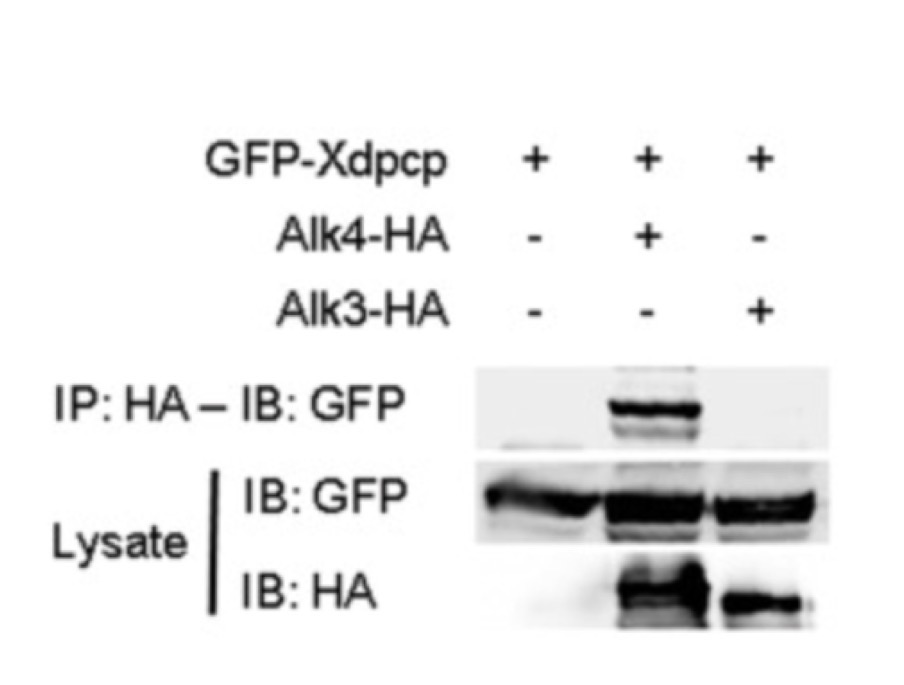
Cheong et al (2009) used a Western blot to identify what type of protein associated with a novel receptor in Xenopus embryos. The top three rows indicate whether the novel receptor (Xdpcp) or a ligand (Alk4 or Alk 3) were present. The bottom three rows are sample Western blot results targeted for the Myc tags or the HA tags. IP = presence in the precipitate (membrane). Lysate = presence in the supernatant (unbound).
Which hypothesis is supported?
1. Xdpcp interacts with Alk4.
2. Xdpcp interacts with Alk3.
3. Xdpcp interacts with both Alk4 and Alk3.
4. Xdpcp interacts with neither Alk4 nor Alk3.
1. Xdpcp interacts with Alk4.
Adams-Oliver Syndrome is caused by a mutation in the
NOTCH1 gene responsible for blood vessel and heart growth.
Consequently, individuals have stunted growth at the
extremities (fingers, toes, and the top of the head). Do you
expect Adams-Oliver Syndrome to be a loss-of-function or gain-
of-function mutation? Explain.
loss of function
Notch pathway is essential for organ growth and repair
Adam’s Oliver syndrome displays as stunted growth, which indicates under expression of notch
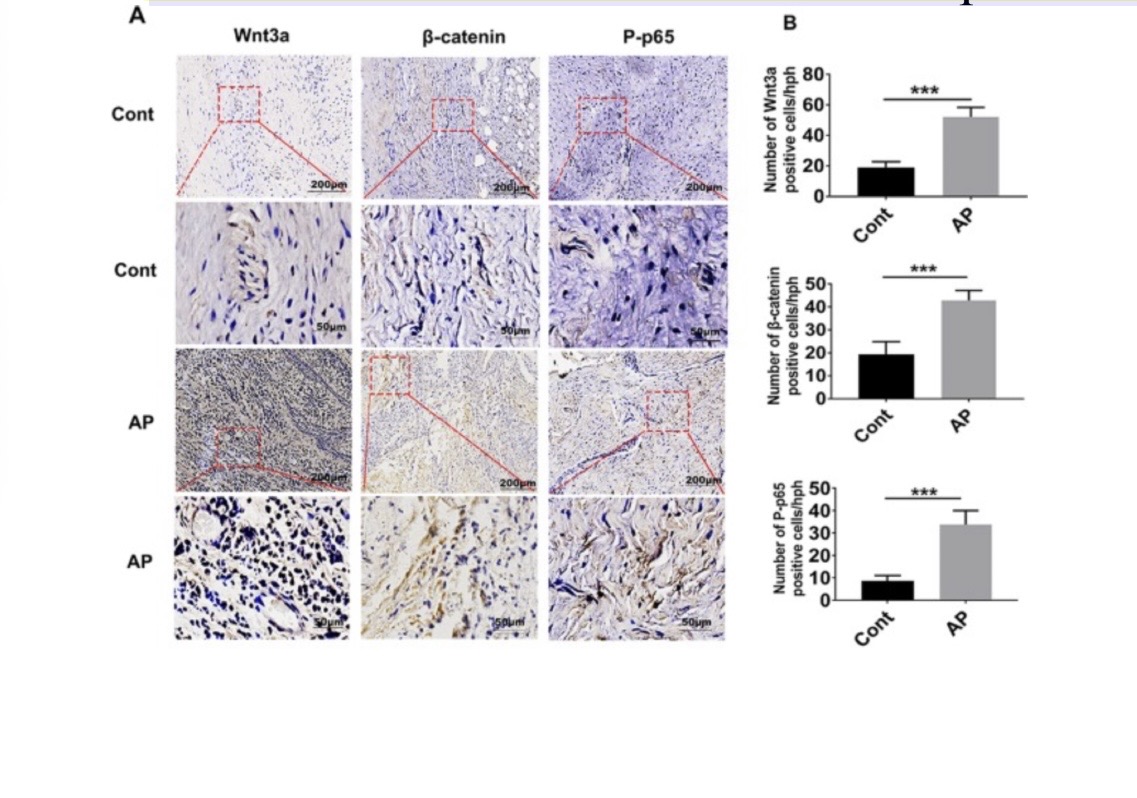
Apical periodontitis (AP) is inflammation of the gums caused by
plaque buildup on teeth near the gumline. Which of the following conclusions are supported by the graph on the left?
Select ALL that apply.
1. Wnt and b-catenin are both activating the same downstream
protein.
2. There is a greater expression of Wnt in AP patients than in
control patients.
3. Wnt and b-catenin have similar expression profiles.
4. These data do not show a dose-dependent response.
2. There is a greater expression of Wnt in AP patients than in
control patients.
3. Wnt and b-catenin have similar expression profiles.
4. These data do not show a dose-dependent response.
Both signal transduction and hormone signaling pathway can…
Crosstalk among pathways
Signal transduction pathway
membrane receptor
3 types (GPCR, enzyme, protein)
Crosstalk among pathways
Hormone signaling pathway
receptor not required
3 types (signal transduction, direct response, indirect response)
Crosstalk among parhways
Study photo
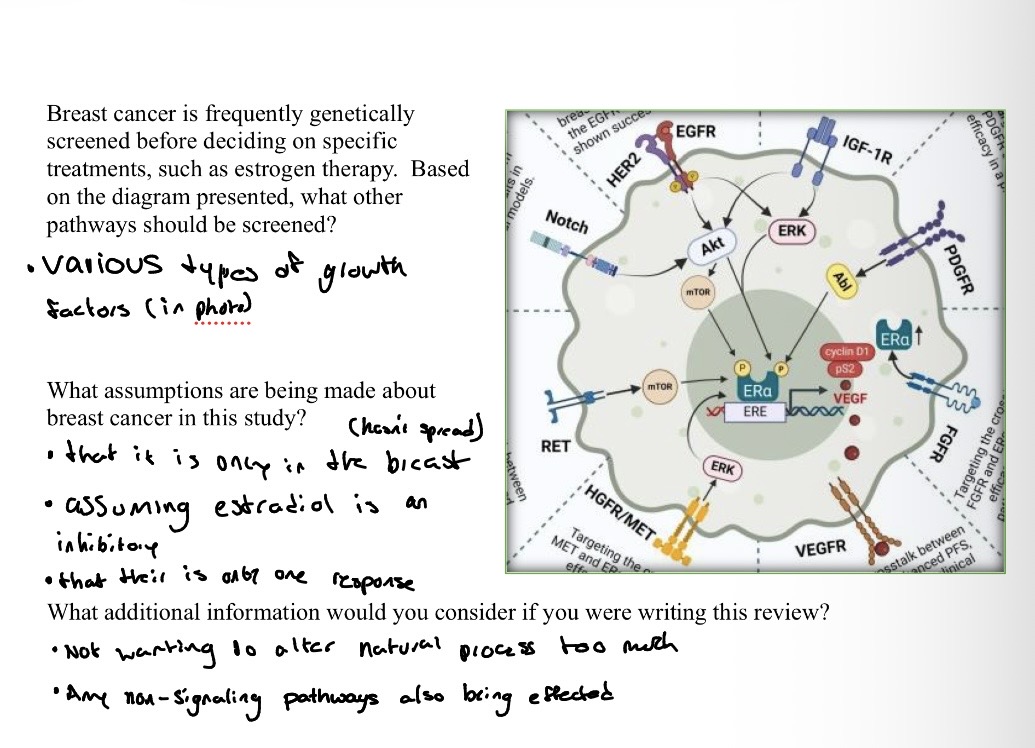
Which of the following statements about the insulin pathway is
FALSE?
1. The insulin pathway activates a number of other proteins in a
signaling cascade.
2. Insulin primarily alters blood glucose levels by directly targeting the GLUT4 vesicles for exocytosis.
3. The insulin receptor is activated most when insulin binds to it.
4. Insulin resistance, due to cell adaptation, can alter other, non-
metabolic cellular responses.
2. Insulin primarily alters blood glucose levels by directly targeting the GLUT4 vesicles for exocytosis.
3. The insulin receptor is activated most when insulin binds to it.
The low oxygen response pathway is shown in the diagram to the left. Which part of the low oxygen pathway distinguishes it from a signal transduction pathway? Select ALL that apply.
1. The signaling molecule is not a protein.
2. The response is not transcription.
3. The signaling molecule is not bound at the surface.
4. The message is not transduced intracellularly.
3. The signaling molecule is not bound at the surface.
4. The message is not transduced intracellularly.
Another photo to study

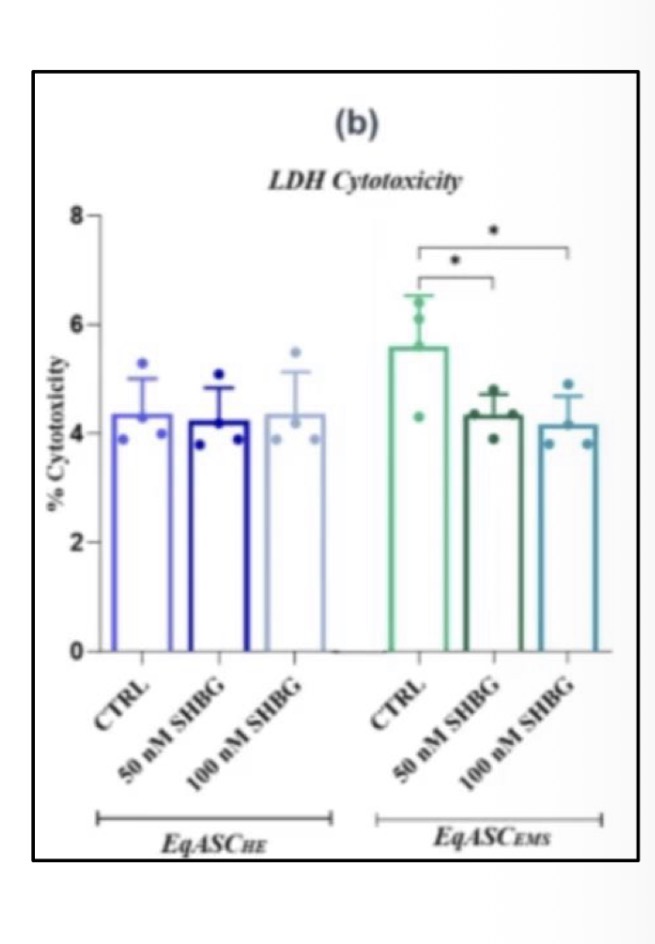
Bourebaba et al (2023) tested a treatment for equine metabolic syndrome: supplemental sex-hormone binding globulin (SHBG). They tested 0 nM, 50 nM and 100 nM in two treatments: healthy horses (CHE) and diabetic horses (CEMS). What conclusions can you make from this graph?
treatment with SHBG was effective in maintaining diabetic horses to match healthy
Additionally not negatively affecting a healthy horse
There is an unlabeled figure in the Abstract of this paper. This figure is a graphical
abstract of the paper. Describe what the authors were trying to test using the graphical
abstract. Specifically answer how the 4A Insertion changes the ability of the G-protein to undergo a conformational change.
The authors were asking if the sliding of the “arm” of the GTPase was a necessary transition state for the activation of the protein.
BRET (Bioluminescence Resonance Energy Transfer) is a technique very similar to
FRET, except is uses a bioluminescent tag instead of a fluorescent tag. Like FRET,
BRET can be used to measure when two proteins are close together. Look at Figure 2.
What does panel A tell you about the ability of M4R-Rluc8 (a GPCR) to interact with
Ga-venus (a G-protein) when the G-protein is holding a GTP molecule (the “agonist”
time) and when it’s holding a GDP molecule (the “GDPS” time)?
In the WT, we observe a confirmational change whereas in the 4A insertion, we do not.
Specifically, in WT, the beta subunit (GDPS) starts near the alpha unit, because it is bound by a GDP molecule. In the presence of Ach, which activates the GPCR, the beta subunit moves away from the alpha subunit to enable the dissociation of the GDP.
At the same time, the gamma subunit (Ga-venus) slowly replaces the beta subunit, in the WT because the GDP molecule has
been replaced whereas in the 4A insertion, the gamma subunit begins interacting right away because of the presence of GDP
Figure 3 shows data from several more BRET experiments. Every graph shows the
binding of a GPCR with a wild-type G-protein (thinner lines) or the 4A mutant G-protein
(thicker lines). Each graph of panel A shows the interaction of the proteins in the
presence of a different signaling molecule (the agonists). Each graph of Panel B shows
the interaction of the proteins in the presence of different inhibiting molecules (the
inverse agonists). Describe the pattern of interaction between GPCRs and their G-
proteins.
When the G-protein has the 4A mutation, it stays associated with the GPCR as seen by the consistently higher levels of BRET in the figures. Even the presence of an “inverse agonist” (which should cause the unbinding of the GPCR and G-Protein) was only modestly successful at decreasing the levels of BRET with concentration.
Look at Figure 6 and read the description. Panel A shows a BRET heat map between
several “orphan” GPCRs and the 4A mutated -subunit of four different classes of G-
proteins. Orphan GPCRs don’t have known G-proteins for their signal transduction
pathways. How many classes of G-proteins does each orphan GPCR typically interact
with? Explain why several orphan GPCRs can interact with the mutated G-protein but
not the wild-type G-protein of the same class.
4 (GS, Gi, Gq and G12) are the classes. The interaction between the orphan GPCRs and the 4A mutant make sense since these GPCRs don’t already have a functioning binding regime with the G-proteins currently. The 4A mutants are structurally different (specifically, longer “arm”), so it doesn’t need to go through a conformational change to activate the orphan GPCRs
Panel C of Figure 6 shows a BRET heat map of GPCRs with known G-protein pathways
interacting with GDP-bound G-proteins. Do G-proteins normally interact with GPCRs
when they are bound by GDP? If the top group of GPCRs (GDP-sensitive) interact with
both the wild-type and mutated G-proteins, what are the implications for the hypothesis
of the paper (your answer for Q1)? If the middle group of GPCRs (GDP-insensitive) do
not interact with either the wild-type or mutated GPCRs, what are the implications for the hypothesis of the paper?
Yes, normally the first step in the activation of a G-protein is the swapping of GDP to GTP so that the GTPase has the high energy nucleotide needed for performing its task later on. This supports the idea that the arm’s sliding motion is a required intermediate step. The lack of response in GDP-bound or 4A mutant GPCRs suggests their mutations disrupt another structural feature that prevents proper interaction.
Examine the figure in the Abstract on the website—only visible on the website—and/or
read the Abstract. What are the authors trying to achieve using synthetic receptors?
What is the challenge with synthetic receptors?
The authors want to change the response of enzyme activated pathways by building enzyme receptors with different cytosolic-side peptide chains.
Look at Figure 1A. How did the authors modify cytokine receptor pathways?
The authors replaced the cytosolic ligands with desired ones.
Look at the graph in Figure 1C. Here, the authors tested whether the original receptors
(VEGFA165 and VEGFA121) would generate a signal when bound by a signaling
molecule (the “ligand”). The authors measured the responding signal as “Reporter
Expression.” Below the bar graphs are a range of ligands the authors tested. What
pattern do you notice in terms of the response (Reporter Expression) of the original
receptors in the presence or absence of the signaling molecules? Why did the authors
need to demonstrate this behavior in the original (wild type) receptors?
Overall, the response is greater when the receptors and ligands are coexpressed. This confirms that the ligands do bind their receptors, ensuring that any later loss of function comes from cytosolic mutations rather than binding defects.
In Figure 1D, the authors added additional copies of the gene VEGFA165 to eukaryotic T
cells by injecting them with DNA plasmids. The concentration of plasmids per cell is
shown on the x-axis. What is the general pattern of VEGFA165 concentration to
response?
In general, more receptors means stronger response.
In Figure 1E, the authors began mutating certain domains of the VEGFA165 gene
(NTEVp and CTEVp). The authors report both the response (Reporter Expression) and
fold induction (FI) of each ligand/reporter pair. Higher FI values indicate greater binding
between the reporter and ligand, and the original (that is, not mutated) version of the gene
is identified for comparison. What is the general pattern between no ligand present and
ligand coexpressed with VEGFA165? What is the general pattern between mutant
VEGFA165 genes and the original gene? Why did the authors need to demonstrate this
response in the mutant genes?
In general, the response was better when the ligand and receptor were both present. While it was sometimes possible to generate the response without the ligands activating the receptors, it was usually less effective. In general, the mutant VEGFA165 genes were better at signaling than the original gene. There was one mutant that was less effective, but most mutants had greater levels
of reporter expression than the original pair. Similar to Q3, the authors are trying to rule out alternative explanations. In this particular experiment, the authors are confirming that the mutants they generated are capable of generating a cellular response. Any absence of the response is not the result of poor signaling
Look at Figure 2C. The authors tested the response again, using an immunoresponse
chain triggered by interleukin-10 (IL-10). In what ways are the expression patterns of 1C
similar to 2C? In what ways are they different? What does this mean about the utility of
the authors objective? Refer back to Q1 if needed.
Co-expressing ligand and receptor showed the engineered receptors triggered the intended cellular response, and binding strength wasn’t tested because the ECM side wasn’t mutated.
In Figure 2F, the authors measured the response (Reporter Expression) as a function of the ligand concentration (IL-10). What is the general pattern? How does this compare to
Figure 1D? In what ways are they similar? In what ways are they different?
The general pattern is that the more signal that is present, the more cellular response is generated.
Look at Figure 3B. The authors generated synthetic receptors for these experiments by
using a viral transposon called PiggyBac that inserted the genetic code for the receptors
into Jurkat cancer cells. Specifically, they altered the transcription factor released by the
IL-10 receptors. The authors then purified the cells that inherited the synthetic receptors
based on one of two criteria (integration with puromycin or marker expression). The
third graph in the row (right) stacks the data from the two previous graphs on top of each
other. Overall, how effective was the transposition? In other words, are the synthetic
receptors responding in a dose-dependent pattern?
Overall, the transposon was successful in inserting the synthetic receptor code into the genomes of the Jurkat cells. This is supported by the observation that the infected cancer cells increased their cellular response when the signaling molecule concentration was increased.
Look at Figure 4A. Here, the authors tested what they called an “Or Switch.” They used
synthetic receptors of VEGF and IL-10 that would generate the same cellular response.
Now look at Figure 4B. Were the authors successful? In other words, did the authors
create a synthetic receptor that would create a unique cellular response based on exposure
to either VEGF or IL-10? Explain
Both receptors triggered the desired response, but the IL-10 receptor produced a stronger effect, shown by the deeper red color when IL-10 or VEGF were present.
Look at Figure 4C. Here, the authors tested what they called an “And Switch.” They
used the synthetic receptors of VEGF and IL-10 that would generate the cellular response
only if both pathways were activated. Now look at Figure 4D. Were the authors
successful? In other words, did they create a pair of synthetic receptors that would
generate a unique cellular response when exposed to both VEGF and IL-10? Explain.
Mostly, yes. While there was some elevated expression above baseline when only one signal was present (pink hue), there was a much greater response when both signals were present (red hue). The slight coloration when only one is present does suggest that there are likely some crosstalk pathways that the authors have not been able to identify, or that the receptors are never fully “off,” only reduced activity when the signaling molecule is present. But having both provides a measurable increase in the response
Read the abstract. What is the effect of GLP-1 on the pancreas? Combining your
knowledge of the insulin receptor (IR) pathway with the information presented in the
abstract, how does GLP-1 enhance insulin secretion?
GLP-1 stimulate the pancreas to release insulin. Normally, the influx of glucose through the GLUT transporter is enough to initiate a response by the cell, but in individuals with Type-II diabetes, this response pathway is impaired. As such, individuals do not produce sufficient insulin to regulate their blood sugar, but GLP-1 can more readily activate the pancreas to release
insulin.
Read the last paragraph of the Introduction. What is the authors’ hypothesis? In other
words, what do they suggest is responsible for the metabolic actions of GLP-1? What is
the role of Hif-1 in this pathway?
The authors suggest that GLP-1 triggers insulin release through the PI3K and mTOR pathways, with HIF-1α acting downstream of mTOR to boost glycolysis in GLP-1-treated cells.
Exendin-4 (Ex-4) is a small peptide chain that can bind to GLP receptors of the pancreas
and activate the receptor pathway. Ex-4 is an analogue to GLP-1, meaning it can behave
very similar to GLP-1. Look at Figure 1B-G. Overall, what was the effect of Ex-4 on
cellular metabolism after 24 hours?
Overall, Ex-4 enhanced the metabolic rate of pancreas cells
The extracellular acidification rate (ECAR) measures the amount of acidification that
occurs near a cell surface as a result of anaerobic respiration. Look at Figure 2A-C.
These graphs measure the amount of anaerobic respiration of the control cells (no Ex-4) compared to cells that were treated with Ex-4 for 18 hours. Overall, what was the effect
of long exposure of Ex-4 on anaerobic respiration? Would this trend be generally helpful or generally harmful for individuals with hyperglycemia (that is, high blood sugar)?
Overall, long exposure to Ex-4 enhanced anaerobic respiration.
Look at Figure 2D-2F. These graphs measure the amount of anaerobic respiration of the
control cells (no Ex-4) compared to cells that were treated with Ex-4 for ~30 minutes.
Overall, what was the effect of short exposure of Ex-4 on anaerobic respiration? How
does this compare to the results in Fig. 2A-C?
Overall, short exposure to Ex-4 did not change anaerobic respiration.
Look at Figure 3A. The authors measured mRNA expression of several kinases.
Overall, what was the effect of Ex-4 on kinase gene expression?
For most kinases, Ex-4 increased kinase activity.
Look at Figure 3B-H. Fig. 3B is a measure of the amount of active protein over time for
several kinases (the intensity of -tubulin is used to estimate the concentration of the
other proteins detected). Fig. 3C-H are line graphs of the same data in 3B. Is this data
consistent with 3A?
Yes, the kinases show increased expression rates over time as they were exposed to sustained levels of Ex-4.
Look at Figure 5A. Here, the authors used Torin-1 and LY2940002, which both inhibit
PI3 kinase, in the presence and absence of Ex-4. Describe the pattern in the graph in
your own words
If PI3 kinase activity is inhibited, glucose consumption does not increase. This strongly supports that Ex-4 is increasing glucose consumption by activating the PI3 kinase pathway.
Consequently, when PI3 kinase is inhibited, the beneficial impacts of Ex-4 are also inhibited
Forskolin is a small molecule that assists in the production of cAMP. Under what
conditions are cells likely to produce cAMP? How would the effect of forskolin compare
to the effect of Ex-4/GLP-1?
Low energy levels trigger cAMP production, which signals the need to raise blood glucose. Forskolin likely mimics this by activating similar glucose-uptake pathways as Ex-4/GLP-1.
Look at Figure 6A, which is measuring change in HIF-1 expression. What effect does
Ex-4 and/or forskolin have on HIF-1 expression?
Ex-4 is increasing HIF-1a expression, and forskolin is increasing HIF-1a expression. This is consistent with the prediction in Q9.
Look at Figure 6C, what effect do Torin-1 and LY2940002 have on HIF-1 and mTOR?
Using your knowledge from Q8, what can you infer about the signaling pathway of PI3
kinase in these cells?
Inhibiting PI3 kinase with Torin-1 or LY2940002 blocks HIF-1α activation, showing that PI3 kinase normally activates HIF-1α.
In Figure 6D, the authors used small interfering RNA (siRNA) to block HIF-1 gene
expression and measure the amount of change in gene expression of three protein
transcripts (HIF-1 Pdh, and Pfkb). What is the pattern you observe? Using your
knowledge from Q8 and Q11, what can you infer about the signaling pathway of PI3
kinase in these cells
Ex-4 activates all three proteins, placing them in the same pathway. Because inhibiting HIF-1α reduces—but does not completely block—Pdh and Pfkb activation, these enzymes likely act downstream of HIF-1α but can also be activated by other pathway components.
HIF-1 is an important cellular censor and responder to low oxygen levels. What does
your answer from Q12 imply about the signaling pathways of GLP-1 and hypoxia?
When cells rapidly consume energy, often they perform anaerobic respiration because they are consuming the oxygen faster than it can be replenished. In turn, anaerobic respiration consumes glucose faster than aerobic respiration. Consequently, hypoxia at the cellular level is often associated with low energy availability and can cause the cells of the body to uptake glucose from the blood. Since GLP-1 also causes cells of the body to uptake glucose (through stimulation of the release of insulin), the HIF-1a pathway matches with this goal. It seems
reasonable that cells would activate the HIF-1a pathway as part of the GLP-1 signaling response
G-Protein Signaling
A cell signaling mechanism where binding of a ligand to a GPCR causes a conformational change that activates G-proteins, which swap GDP for GTP to transmit signals
Cell Signaling
Cell-to-cell communication that is essential for coordinating cellular activities and responses
Signaling Molecule
A molecule produced by a signaling cell that includes proteins, peptides, amino acids, nucleotides, steroids, retinoids, fatty acid derivatives, dissolved gases, or ions
Receptor
A protein produced by the target cell that may be at the cell surface, in cytosol, or in nucleus, and is specific to its signaling molecule
Effector Protein
A protein that creates the cellular response and includes enzymes, transcription factors, ion channels, and more
Autocrine Signaling
A type of cell signaling where a cell produces signals that bind to receptors on its own surface
Paracrine Signaling
Cell signaling that occurs over short distances between nearby cells
Endocrine Signaling
Long-distance cell signaling where hormones travel through the bloodstream to reach distant target cells
Signal Transduction Pathway
The series of chemical interactions that occur from the binding of a signaling molecule to its receptor until the final cellular response
Secondary Messenger
Molecules used within the cell to create changes in the cell's behavior and amplify the signal from the receptor
cAMP
A secondary messenger created from ATP by adenylyl cyclase that is normally abundant when cells have exhausted their ATP supply
Signal Amplification
The process by which one signaling molecule continues to generate multiple secondary messengers until the signaling molecule is removed, greatly amplifying the original signal
GPCR
G-Protein Coupled Receptor, a cell surface receptor that undergoes conformational change upon ligand binding to activate G-proteins
G-Protein Activation
The process where an active GPCR causes the G-protein to swap GDP for GTP, activating it to transmit signals
Adenylyl Cyclase
An enzyme turned on by activated G-proteins that creates cAMP from ATP
Dissociation Constant (KD)
A measure of binding affinity between a signal and receptor; smaller KD means stronger binding affinity and longer/stronger signaling
Signal Strength
Depends on the amount of signal, amount of receptor, and the dissociation constant between signal and receptor
SSRIs
Selective Serotonin Reuptake Inhibitors that block the reuptake of serotonin, increasing its availability in the synapse to reduce anxiety and depression
Epinephrine Pathway
A GPCR pathway, activates G-proteins, which stimulate adenylyl cyclase to produce cAMP, leading to multiple downstream cellular responses.
GPCR Diseases
Endocrine system diseases caused by mutations in GPCRs, including hypothyroidism, hyperthyroidism, hypogonadism, nephrogenic diabetes insipidus, and glucocorticoid deficiency
Receptor Tyrosine Kinases (RTKs)
Enzyme-linked receptors that are part of a large category capable of activating signaling pathways themselves, unlike G-protein coupled receptors
Enzyme-linked receptor dimerization
Process where enzyme-linked receptors exist as monomers with low activity until a signaling molecule causes them to dimerize and become active
Kinase
An enzyme that attaches a phosphate from a nucleotide (such as ATP) to a substrate
Autophosphorylation
The ability of some kinases (especially RTKs) to phosphorylate themselves to increase their own activity
Ras/MAP Pathway
A model RTK system that responds to growth factors and is a frequent target in cancer therapies
RTK specificity
The characteristic of most RTKs being very specific to prevent signals from activating multiple pathways, while also allowing crosstalk for fine-tuned responses
Crosstalk
Communication between different signaling pathways that enables super fine scaling of cellular response
Receptor down regulation
A slow adaptation mechanism involving receptor-mediated endocytosis to reduce cellular response
Receptor phosphorylation
A rapid adaptation mechanism that modifies receptor activity quickly
Psoriasis mechanism
Inflammation through RTK pathways leading to hyper-proliferation of keratinocytes, resulting in buildup of undifferentiated cells in skin layers